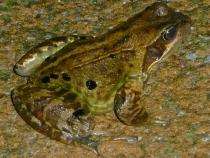Study suggests link between agricultural chemicals and frog decline

(PhysOrg.com) -- Around the world, amphibian populations are in decline, and scientists have not been able to figure out why. Now a study of leopard frogs in Pennsylvania has identified a possible culprit, and the ramifications are troubling, according to a Penn State ecologist.
Research conducted primarily at Penn State's Russell E. Larson Agricultural Research Center at Rock Springs in the summer of 2007 — described in a recently published article in the journal Nature — suggests that chemical pollution can increase often-deadly trematode (parasitic flatworm) infections in a declining amphibian species.
"Like canaries used to gauge the safety of air in coal mines, amphibians are thought to be the 'canaries' in our freshwater environments, and reductions in their health can warn that subsequent species declines might be in store," says Hunter Carrick, associate professor of aquatic ecology in Penn State's College of Agricultural Sciences, who was one of the lead investigators in the study.
"The scientific findings point to worrisome synergisms between two commonly used agro-chemicals that, when combined, can produce a lethal effect to frog populations at concentrations that are often observed in wetland ecosystems."
The study looked at atrazine, a widely used herbicide, and phosphate, a primary ingredient in fertilizers. "When combined, they accounted for 74 percent of the variation in larval trematode abundance in the frogs,” says Carrick.
These agrochemicals increase trematode infections by augmenting snail intermediate hosts (phosphorus) — the source of trematodes that infect amphibians -- and suppressing amphibian immune responses (atrazine), explains Jason Rohr, assistant professor of integrative biology at the University of South Florida, who was the principal investigator in the research. Rohr was a postdoctoral fellow in Penn State's College of Agricultural Sciences during much of the project, which was funded by grants from the National Science Foundation, the U.S. Department of Agriculture and the Environmental Protection Agency.
According to Rohr, identifying the main risk factors and predictors for disease in amphibians is important. The study showed that atrazine and phosphate concentrations in wetlands they investigated were the best of more than 240 plausible predictors of trematode abundance in frogs. In a manipulative experiment conducted with 300-gallon tanks outdoors at Penn State's Larson Agricultural Research Center, Rohr and colleagues verified that atrazine and phosphate increased snail abundance, caused amphibian immuno-suppression and elevated amphibian trematode loads.
"At concentrations commonly occurring in freshwater ecosystems, atrazine and phosphate can be drivers of amphibian trematode infections, raising concerns about the role of these chemicals in amphibian declines," concludes Rohr. "Reducing atrazine and phosphate inputs to wetlands might remediate these often-debilitating amphibian trematode infections."
Atrazine and phosphate might not be the only chemicals affecting disease risk, notes Carrick. "Many chemicals can be immuno-suppressive, and standard toxicity tests used to register chemicals in the United States and Europe are conducted on isolated individual organisms, often ignoring interactions with other species, such as their parasites," he says. "Thus, our findings are likely the tip of the iceberg for pollution-induced disease emergence in both humans and wildlife."
Leopard frogs are a species of concern in Pennsylvania because of the marked decline in their population, Carrick points out. Scientists had been unable to explain their shrinking numbers, suspecting growth in predator populations, habitat degradation or climate change. "Now we have shown that these chemicals combine to increase infections in amphibians, and this is a plausible explanation for their decline," he says.
"The scope of this research is unique," explains Carrick. "We used 72 cattle tanks to create experimental wetland environments for the frogs, and we administered 18 different chemical treatments using off-the-shelf pesticides — four replicate tanks each. They were surrogates for small ponds, and we seeded each with a food web representative of those that naturally occur in wetlands here in the mid-Atlantic region."
The study results should be an eye-opener for society, Carrick contends, because atrazine and phosphate are common, widely used ingredients in off-the-shelf pesticides and fertilizers, respectively. And phosphorus can be prevalent in animal and human waste.
"We need to be asking, are we are putting things into the environment that work together to make big ecological differences?" he says. "Chemicals in nonlethal doses may not be dangerous alone, but we could be underestimating the threat that common compounds pose when combined."
Provided by Pennsylvania State University


















